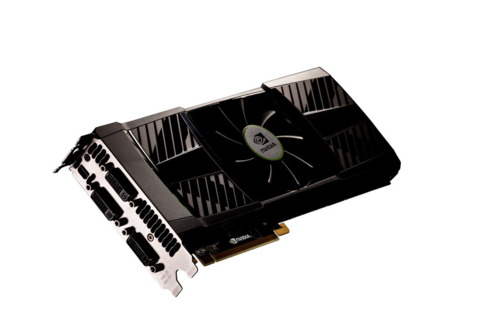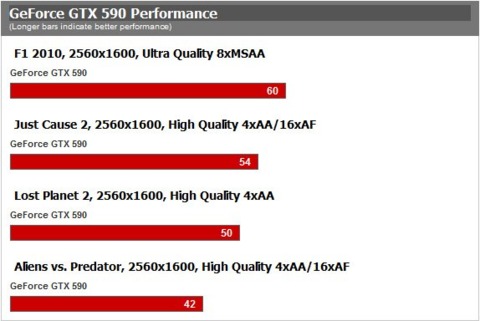Nvidia GeForce GTX 590 Hands-On Preview
Nvidia releases the dual GPU GeForce GTX 590.
The word "enough" doesn't exist in a GPU manufacturer's vocabulary. They will always find a way to do more. And now, after advancing from the GeForce GTX 480 to the GeForce GTX 580, Nvidia finds itself releasing the GeForce GTX 590. It's a behemoth of a card, weighing in with not one, but two GeForce GTX 580 GPUs and a mind-boggling $700 price tag.

Nvidia has jammed two powerful GeForce GTX 580-class processors onto a single board. The company couldn't pull off the same feat last year with the hotter-running GeForce GTX 480. Like in dual-GPU cards before it, the chips aren't clocked as high as their single GPU brethren. Squeezing a pair of power-hungry GPUs onto the same board brings up issues of heat and power--not to mention the fact that you have to double almost everything else and still keep it within nearly the same physical space.
In terms of internals, the GeForce GTX 590 has a pair of fully functional 512 core GeForce GTX 580s and 3072MB of GDDR5 memory (1536MB per GPU). Nvidia clocked the chips at 607MHz, and the RAM speed is set at 3414MHz. By comparison, a single GPU GeForce GTX 580 has a core that runs at 772MHz and GDDR5 memory clocked at 4000MHz.
A pair of gigantic vapor chamber coolers keep the GeForce GTX 590 cool. A single fan pushes air across both chips. On the back side of the card you'll find a set of aluminum plates that help to cool off the RAM. Nvidia also made it easy to remove the fan shroud to clean out dusty internals. In use, the GeForce GTX 590 doesn't emit an excessive amount of noise. The card is substantially quieter than the raucous GeForce GTX 480.
On the connector side of things, the GeForce GTX 590 breaks from Nvidia's dual-monitor limitation. The GeForce GTX 590 has three dual-link DVI connectors and is the first Nvidia card to also feature a Mini DisplayPort output. You can connect up to three monitors using a single GeForce GTX 590, making it possible to have 3D Vision surround from a single card.
The GeForce GTX 590 uses two eight-pin power connectors to get the juice it needs. And it needs a lot. Nvidia recommends at least a 700W power supply. For those feeling a bit frisky and contemplating a quad-SLI setup, Nvidia recommends a power supply in the 1200W range.

We don't have the recently released Radeon HD 6990, the GeForce GTX 590's direct competitor, on hand for testing. We've produced some performance metrics of the GeForce GTX 590 here; for a full rundown, we're going to defer to Anandtech.
No doubt about it, the GeForce GTX 590 is a powerful card. And it's definitely not for the cost conscious among us. $700 buys you a lot of performance rolled into a single card. But if all you're looking for is brute speed, two $350 GPUs like the GeForce GTX 570 or the Radeon HD 6970 running in SLI or CrossFire mode will get you better frame rates. If you factor in rebates, they'll get you there for even less than the price of a single GeForce GTX 590. However, if noise and space constraints are paramount issues, the GeForce GTX 590 will get you those frames with a bit more style. Outside of that, dual GPU cards like the GeForce GTX 590 and the Radeon HD 6990 really serve one purpose: bragging rights for the companies involved.
Got a news tip or want to contact us directly? Email news@gamespot.com

Join the conversation